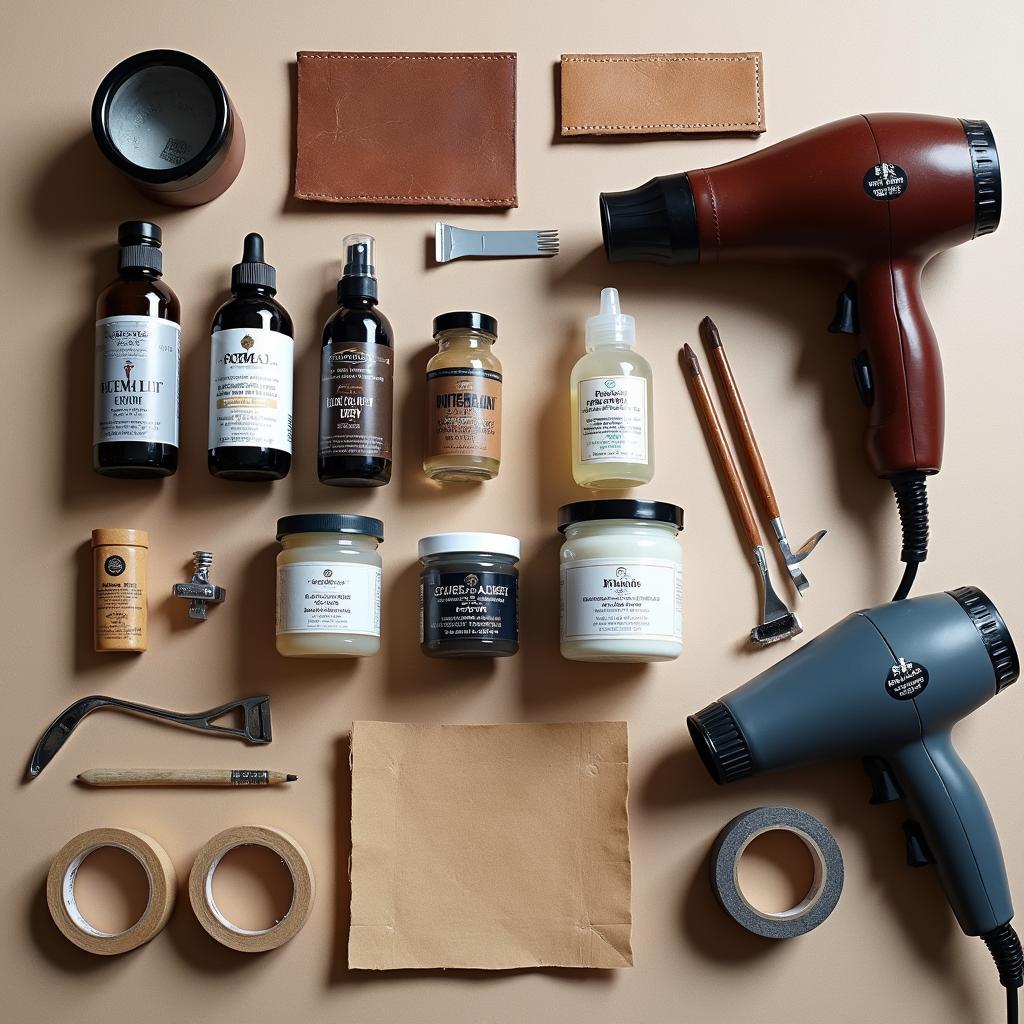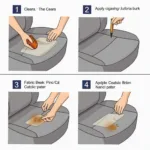Leather car seats add a touch of luxury and comfort to any vehicle. However, over time, they can develop unsightly cracks due to wear and tear, sun damage, and temperature fluctuations. While these cracks might seem like a major problem, they can often be repaired at home with the right tools and techniques. This comprehensive guide will walk you through everything you need to know about how to repair leather car seat cracks, from assessing the damage to achieving a professional-looking finish.
Understanding Leather Car Seat Cracks
Before you start the repair process, it’s essential to understand the type and severity of the cracks you’re dealing with.
- Surface Cracks: These are small, shallow cracks that only affect the top layer of the leather. They are typically caused by dryness and can often be repaired with leather conditioners and fillers.
- Deep Cracks: These cracks extend through the entire thickness of the leather and often expose the underlying material. They are typically caused by age, wear and tear, or improper cleaning methods. Deep cracks require more extensive repairs using leather filler, patches, and dyes.
- Tears and Rips: These are more severe forms of damage where the leather has actually split apart. While small tears can sometimes be repaired using similar techniques as cracks, larger tears often require professional upholstery repair.
Materials You’ll Need
Gather the following materials before you begin the repair process:
- Leather cleaner and conditioner: To clean the area around the crack and prepare it for repair.
- Leather filler: A paste-like substance used to fill in cracks and create a smooth surface. Choose a filler that matches the color of your leather or one that can be dyed to match.
- Palette knife or spreader: For applying leather filler evenly into the cracks.
- Fine-grit sandpaper: To smooth out the filler after it dries.
- Leather dye (if necessary): To match the color of the repaired area to the surrounding leather.
- Leather sealant: To protect the repaired area and prevent future damage.
- Clean cloths: For wiping away excess cleaner, conditioner, and dye.
Step-by-Step Guide to Repair Leather Car Seat Cracks
Follow these steps to effectively repair cracks in your leather car seats:
- Clean the Area: Begin by thoroughly cleaning the affected area with a leather cleaner to remove dirt, grime, and any residue from previous treatments. Use a soft-bristled brush to gently scrub the cracks and ensure they are free of debris.
- Condition the Leather: Once the area is clean and dry, apply a leather conditioner to hydrate the leather and improve its flexibility. This will help prevent further cracking and make the repair process smoother.
- Apply Leather Filler: Using a palette knife or spreader, carefully fill in the cracks with leather filler. Push the filler firmly into the cracks to ensure good adhesion and create a level surface. If necessary, apply multiple thin layers of filler, allowing each layer to dry completely before applying the next.
- Sand and Smooth: After the filler has dried completely, use fine-grit sandpaper to gently sand down any excess filler and create a smooth, even surface. Be careful not to sand too aggressively, as this can damage the surrounding leather.
- Dye the Repaired Area (If Necessary): If the leather filler you used doesn’t match the color of your car seats, you’ll need to dye the repaired area. Apply the leather dye in thin, even coats, using a sponge or applicator pad. Allow each coat of dye to dry completely before applying the next.
- Apply Leather Sealant: Once the dye is dry, apply a leather sealant to protect the repaired area from future damage. The sealant will help to repel water, dirt, and UV rays, keeping your leather seats looking their best for longer.
Tips for a Professional-Looking Finish
- Practice on a Hidden Area: Before working on the visible cracks, practice the repair process on a hidden area of your car seat to get a feel for the materials and techniques. This will help you avoid making mistakes on the more noticeable areas.
- Use Heat for Faster Drying: You can use a hairdryer on a low heat setting to speed up the drying time of the leather filler, dye, and sealant. However, avoid using excessive heat, as this can damage the leather.
- Work in a Well-Ventilated Area: Leather dyes and sealants often contain strong fumes. Make sure to work in a well-ventilated area or outdoors to avoid inhaling these fumes.
Car Seat Leather Repair: FAQs
Q: How much does it cost to repair leather car seats?
A: The cost of car seat leather repair can vary widely depending on the severity of the damage, the type of leather, and whether you choose to do it yourself or hire a professional.
Q: Can I use super glue to repair cracks in my leather car seats?
A: It’s not recommended to use super glue or other adhesives to repair leather car seats. These adhesives can damage the leather and make the cracks more noticeable.
Q: How do you repair torn leather car seats?
A: Repairing torn leather car seats typically requires a different approach than repairing cracks. Small tears can sometimes be repaired using leather filler and a reinforcing mesh, while larger tears often require professional upholstery repair.
Q: How can I prevent my leather car seats from cracking in the future?
A: Regular cleaning and conditioning are essential for preventing leather car seats from cracking. You should also park your car in the shade whenever possible to protect the leather from UV damage.
Conclusion
Repairing leather car seat cracks can seem daunting, but with the right approach, you can achieve professional-looking results and restore your car’s interior to its former glory. By following the step-by-step guide and tips outlined in this article, you’ll be well on your way to tackling those unsightly cracks and enjoying a comfortable and stylish ride for years to come. Remember, patience and attention to detail are key to achieving a seamless repair.
If you’re uncomfortable with the idea of repairing the cracks yourself, or if the damage is extensive, it’s always best to consult with a professional upholstery repair specialist. They have the expertise and tools to handle even the most challenging repairs and can ensure a flawless finish.
For further assistance or to schedule an appointment with our expert technicians, please contact us via WhatsApp: +1(641)206-8880 or Email: [email protected]. We offer 24/7 customer support and are dedicated to providing top-notch car repair solutions.



